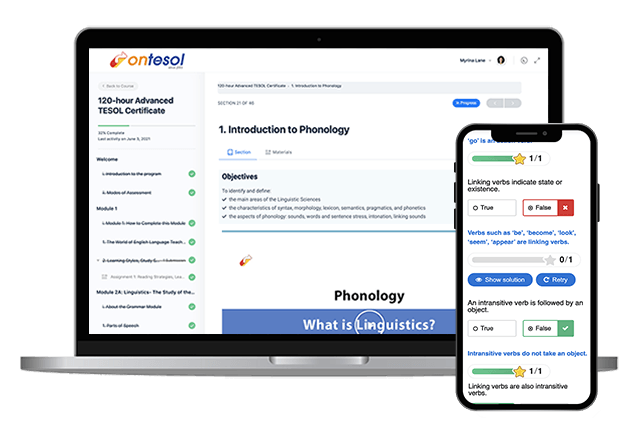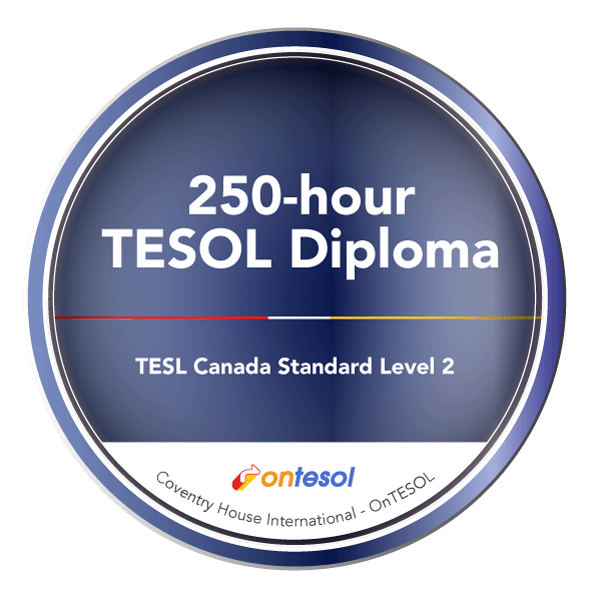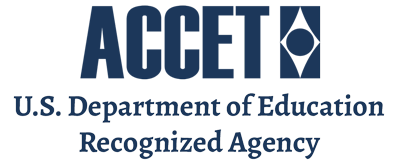250-hour TESOL Diploma
How it Works
You can enroll any time and the course will be activated within 24 business hours. The minimum time necessary to complete this course is 3 months. The maximum time given to complete this course is 10 months.
The 250-hour TESOL Diploma is a semi-synchronous course, meaning that you must attend all the live classes in this course but you can study at your own pace within your course deadline.
Assessment is based on the successful completion of quizzes (7), assignments (8), and a final curriculum project with three (3) lesson plans.
Live Classes via Zoom
Master your lesson planning skills with the 10-hour Lesson Planning Workshop (Via Zoom). Get one-to-one feedback (Via Zoom) from a senior trainer on your final curriculum development project.
*10-hour Lesson Planning Workshop: If you already attended the 4 live classes in the 120-hour Advanced TESOL/TEFL course, you will receive credits toward this component.
Flexible Semi-Synchronous Schedule:
Flexible Attendance: The live classes take pace on a monthly basis, so you can spread your attendance throughout the duration of your course.
Key Dates
Study online at your own pace and attend the live classes when you reach the respective sections in the course.
| Event | Date & Time |
|---|---|
| Workshops 1-4 |
First Tuesday of the month, then every subsequent Tuesday, 6 pm – 8:30 pm (GMT-5, Toronto time).
Starts with Workshop 1 on the first Tuesday and concludes with Workshop 4 on the fourth Tuesday of the month. |
| Workshop 5 | First Thursday of the month, 6 pm – 8:30 pm (GMT-5, Toronto time) |
| Workshop 6 | Third Thursday of the month, 6 pm – 8:30 pm (GMT-5, Toronto time) |
| 1-hr Grammar Tutorial |
Every second Thursday of the month, 6 pm – 7 pm (GMT-5) Attendance is optional |
| 1-hr Phonology Tutorial |
Every fourth Thursday of the month, 6 pm – 7 pm (GMT-5) Attendance is optional |
TESOL Diploma Syllabus
Duration: The online 250-hour TESOL Diploma program was designed for trainees who need to take a TESOL certification course at their own pace in order to meet other work or study commitments. You can enroll any time and the course will be activated within 24 business hours. The minimum time necessary to complete this course is 3 months. The maximum time given to complete this course is 10 months.
Module 1: Advanced Methodology
This module provides an in-depth exploration of teaching methodologies, lesson planning, and classroom strategies for English language instruction. Students will learn about various teaching theories, lesson planning techniques, and strategies for teaching grammar, vocabulary, pronunciation, and the four language skills. Other key topics include error correction, learner assessment, classroom management, and the effective use of teaching materials. Assessments include graded quizzes and three lesson planning assignments, which are evaluated by a tutor.
Module 2: Theory and Theoretical Issues
This module introduces fundamental concepts in First Language Acquisition (FLA) and Second Language Acquisition (SLA), exploring key theories that influence language learning. Students will examine factors that impact adult language acquisition, as well as semantics and pragmatics in communication. Assessment consists of four quizzes, ensuring a solid understanding of the theoretical foundations of TESOL.
Module 3: Teaching Methodologies
Students will explore the historical development of second language teaching and analyze different teaching styles and techniques. Key focus areas include Communicative Language Teaching (CLT), Task-Based Learning (TBL), and controlled practice techniques. Special emphasis is placed on the Concept Question Checking (CQC) technique, which helps gauge students’ comprehension. Assessments include participation in a discussion forum, three quizzes, and multiple assignments designed to deepen practical understanding.
Module 4: Teaching Language Skills
This module examines how to teach speaking, writing, listening, and reading, with a focus on understanding English language proficiency levels. Students will explore phonology, vocabulary, and grammar in relation to skill development. Additionally, a class observation component helps students connect theory to real-world teaching practices. Assessments include a discussion forum, reflection activities, and a major assignment to prepare students for their final project.
Module 5: Curriculum Development
Students will learn the principles of curriculum design, material selection, and course evaluation. This module equips educators with the skills to develop structured courses that align with learning objectives. Assessments include a final project in portfolio format and three lesson plan assignments, allowing students to apply their knowledge in a practical way.
Module 6: Advanced Pedagogical Grammar
This module covers 18 chapters on grammar, ranging from fundamental parts of speech to complex structures like conditionals, passive voice, and reported speech. The final chapter provides ideas for teaching grammar, offering strategies for making grammar instruction more engaging and effective. The module culminates in a comprehensive grammar exam, testing students’ mastery of advanced grammatical concepts.
Module 6: Advanced Pedagogical Phonology
Students will gain a deep understanding of pronunciation, phonemes, syllables, stress patterns, and connected speech. Practical techniques for teaching pronunciation and correcting student errors are covered. The module concludes with a final phonology exam, assessing students’ ability to analyze and improve learners’ pronunciation.
What’s Included in the Tuition Fee?

All Course Material
All course material is included in the tuition fee. You can access our responsive student portal from your desktop, phone, or table and you also have the option to download each chapter in PDF for printing and/or offline viewing.
250-Hour TESOL Diploma And Transcript
Graduates will receive a 250-hour TESOL Diploma and transcript issued by Coventry House International – OnTESOL.
All certificates and transcripts are sent by mail from our office in Toronto. Graduates may also download a digital copy from the student portal.
The certificate is signed by our Director of Studies, stamped, and includes a unique verification number for employers.
Professional Tutor Support
An experienced teacher trainer will be assigned to assist you throughout the program. Your tutor will provide you with extensive feedback on every assignment to help you improve your teaching methods.
OnTESOL only hires teacher trainers with more than 10 years of experience in the ESL classroom and more than 5 years of experience in CELTA, Trinity CertTESOL, or TESL Canada approved courses.
All our tutors are approved by TESL Canada, so you are guaranteed to receive professional tutor support from a qualified and experienced teacher trainer.
Job Placement Assistance
Tuition Fee:  CA$1350
CA$1350 US$950
US$950
COURSE REVIEWS: 250-hour TESOL Diploma
WHAT OUR GRADUATES SAY

“As a graduate of the OnTESOL program, I am happy to recommend it to teachers or potential teachers. Many of our staff at our school have taken the OnTESOL program. We look for teachers who come from quality teaching programs. Seeing OnTESOL certification on a resume means we know the individual has the foundation to become a great teacher”.
James Rice
School Director – Connect Language School (Canada)

“I completed OnTESOL’s 250-Hour TESOL Diploma course, and, sure enough, that boost to my credentials combined with positive references from my time in UAE public schools got me a much better paying position with ADVETI the following school year. I’ve since been able to certify as an IELTS examiner, largely because of my TESOL diploma, which in turn has made me a more attractive candidate to the universities and colleges. Honestly, pursuing my TESOL diploma through OnTESOL was one of the soundest investments I’ve made towards my career as an educator”.
Greg Askew
Teaching in the United Arab Emirates
Optional Practicum
UPGRADE YOUR CREDENTIALS!
The 50-hour Practicum is separate and optional. It’s perfect for people who want to obtain supervised teaching experience and complete a teaching practice module after the TESOL Diploma program. Graduates who wish to pursue TESL Canada Professional Standard 2 certification must complete the 50-hour Practicum.
The 50-hour Practicum module consists of 30 hours of class observation and 20 hours of supervised teaching practice with adult ESL students of different levels.
There are two options for completing the Practicum:
- OnTESOL can give you a list of schools to set up the Practicum in Toronto, Montreal, Vancouver, Halifax, or Edmonton for a fee (Between $900 and $1,500 for the 50-hour Practicum).
- You can also complete the Practicum anywhere else in the world or in the cities mentioned above if you are already teaching at a school or you have access to an ESL class. OnTESOL will approve the teacher, provide the Practicum booklet with guidelines, moderate the reports and lesson plans, and issue the Practicum certificate at no extra cost. Graduates can complete the Practicum in any country, whether at an ESL school, community center that offers ESL classes, LINC program, or TESOL/TEFL institute. The Practicum must be supervised by a teacher with over 2000 hours of teaching experience and an advanced TESOL/TEFL certificate with Practicum (TESL Canada, Trinity CertTESOL, CELTA, TESL Ontario, or SIT TESOL). The students who participate in the Practicum must be older than 18. TESOL Diploma graduates who prefer this option are responsible for finding a qualified teacher who meets the requirements mentioned above and arranging any fees related with supervising the Practicum.
There isn’t a deadline for completing the Practicum, so it is possible to complete this module for free after obtaining employment. Some TESOL institutes offer the Stand-Alone Practicum for a fee. Visit tesl.ca for a list of TESL Canada course providers in different provinces. Some language schools in Canada offer the Stand-Alone Practicum to our graduates, but they charge a fee to those who are not going to enter into a working relationship with them.
250-hour TESOL Diploma
Register Today
Tuition Fee:  CA$1350
CA$1350 US$950
US$950
Teaching a Business Course (TBEC)
Earn more money teaching Business English classes! In general, Business English teachers earn 30% more than language school teachers. In some countries, Business English teachers earn up to $100/hour! This 20-hour Teaching Business English Course will prepare you for one-to-one private tutoring, in-company lessons, and Business English programs at major international language schools. This program is fully online and it will teach you how to assess your learners’ needs, how to develop a syllabus based on lesson plans that meet the unique needs of each Business English student, and how to find appropriate material to cover the main aims of a Business English course.
Teaching English to Young Learners (TEYL)
The 20-hour TEYL Certificate course has been carefully developed to address the needs of young learners. This online TEYL certificate course is perfect for public school teachers, new ESL teachers, and TESOL/TEFL certified teachers who work with students between the age of 4 and 15. This specialist is very popular with those who are teaching English with EPIK in South Korea, NETS in Hong Kong, ADEC in the UAE, English First in China, the JET Programme in Japan, or k-12 programs in North America.
Why is the TEYL Specialist Important?
Teaching children and teenagers is a challenging job, so we designed this course to give you the tools and confidence that you need to stand in front of a class full of rowdy kids!
The 20-hour Teaching English to Young Learners specialist reviews the most effective approaches for teaching grammar and pronunciation, shows trainees how to analyze a TEYL textbook, and provides practical training on how to use the Task-based Learning approach via a major lesson plan assignment.
Teaching English Online
This course will teach you the core elements of teaching a language online, including appropriate technologies and strategies to create your online program or prepare yourself for working for an online language school. You will learn how to evaluate and use online technologies, determine the type of teaching approach or strategies appropriate for your teaching target, and if you wish to be your own boss, learn the basics to design your online program.
Teaching IELTS
Help your students approach the IELTS test with confidence to get the best possible results! In this course, you will find detailed information about the IELTS test and you will also explore strategies and techniques to teach all four papers (Reading, Listening, Writing and Speaking). You will have access to materials for online practice to help you prepare your IELTS lessons.









